This week we conclude our three-part series to walk you through our antics as I traveled with a wonderful group of photographers on my 2020 Hokkaido Winter Landscape Photography Tour.
As with previous days, we were lucky to get a flurry of snow to cover the ground sufficiently to provide the beautiful scenes that we were hoping for, and that I’d been concerned that we might not get, with us having the warmest winter for 60 years this year. Having just gotten back from the first of my Japan Wildlife trips in Hokkaido, I’m happy to say that we had a cold front come in for most of the time we were up there, and there’s another forecast for next week when I set out for my third and final Japan trip of the year.
We pick up the trail on day eight of my Landscape Tour today though, as we left Wakkanai and headed first for the fishing ports near Cape Souya, and the northern-most tip of Japan, so let’s look at a shot from there to start with. As you can see, the snow wasn’t deep, but it was enough, and quite clean at this spot too, without much grass showing through.
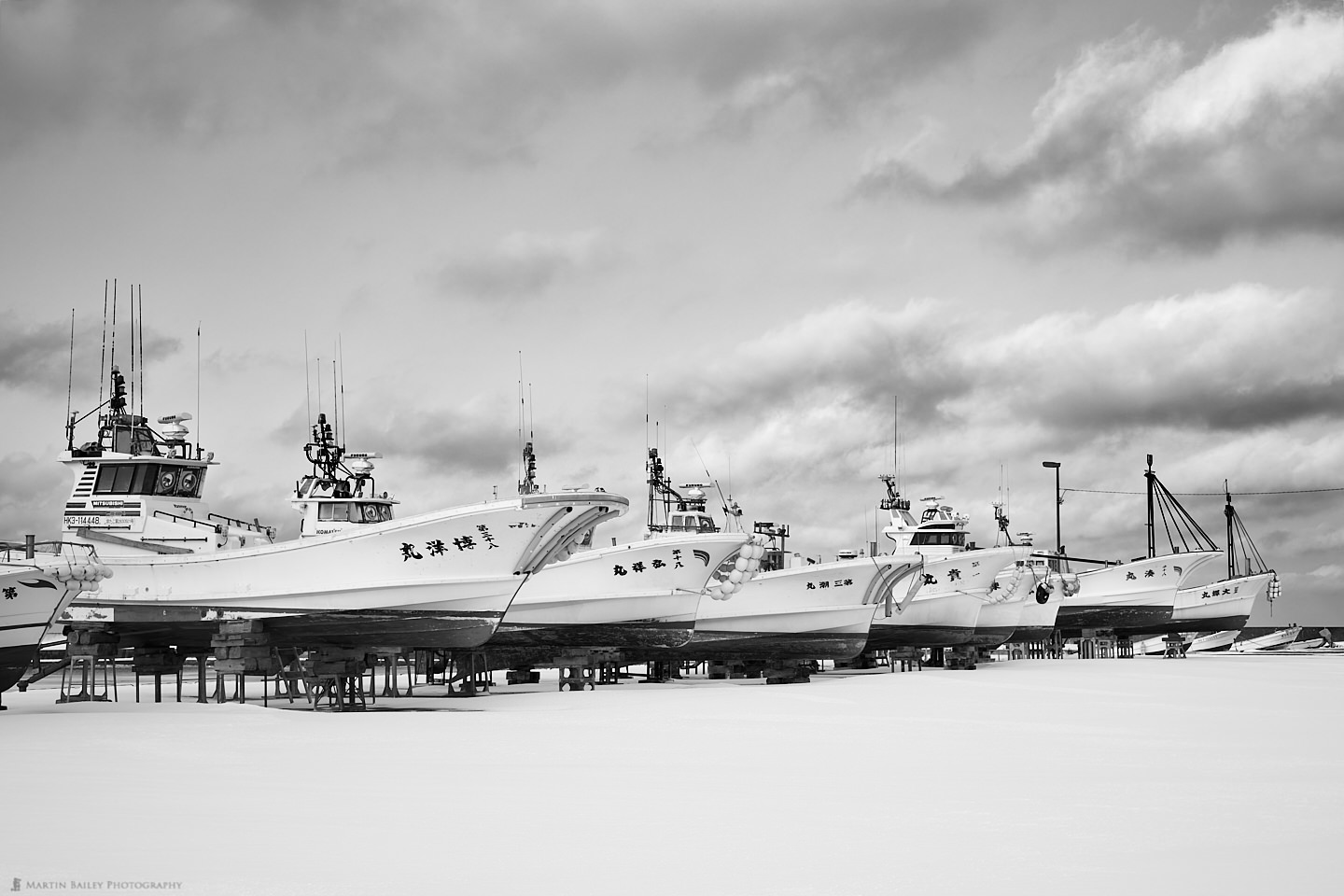
I’ve processed most of my images from this trip in black and white, as I feel that it suits the subject matter most of the time. I also like to see a little conformity in the sets of images that I come back from these trips with, although as we’ll see later, there were a few shots towards the end of the trip that, in my opinion, worked better in color.
The next photograph, on the other hand, was shot on medium format black and white film, so I don’t really have a choice, but I think these images suit the Hokkaido Landscape work really well. For this I used an ND400 which gives me 8.6 stops of darkness for a 60-second exposure at f/16, to enable me to smooth over the sea like this. I had an ND8 and ND400 filter custom made here in Japan, to fit on the bayonet filter holder on my Rolleiflex to make this possible.
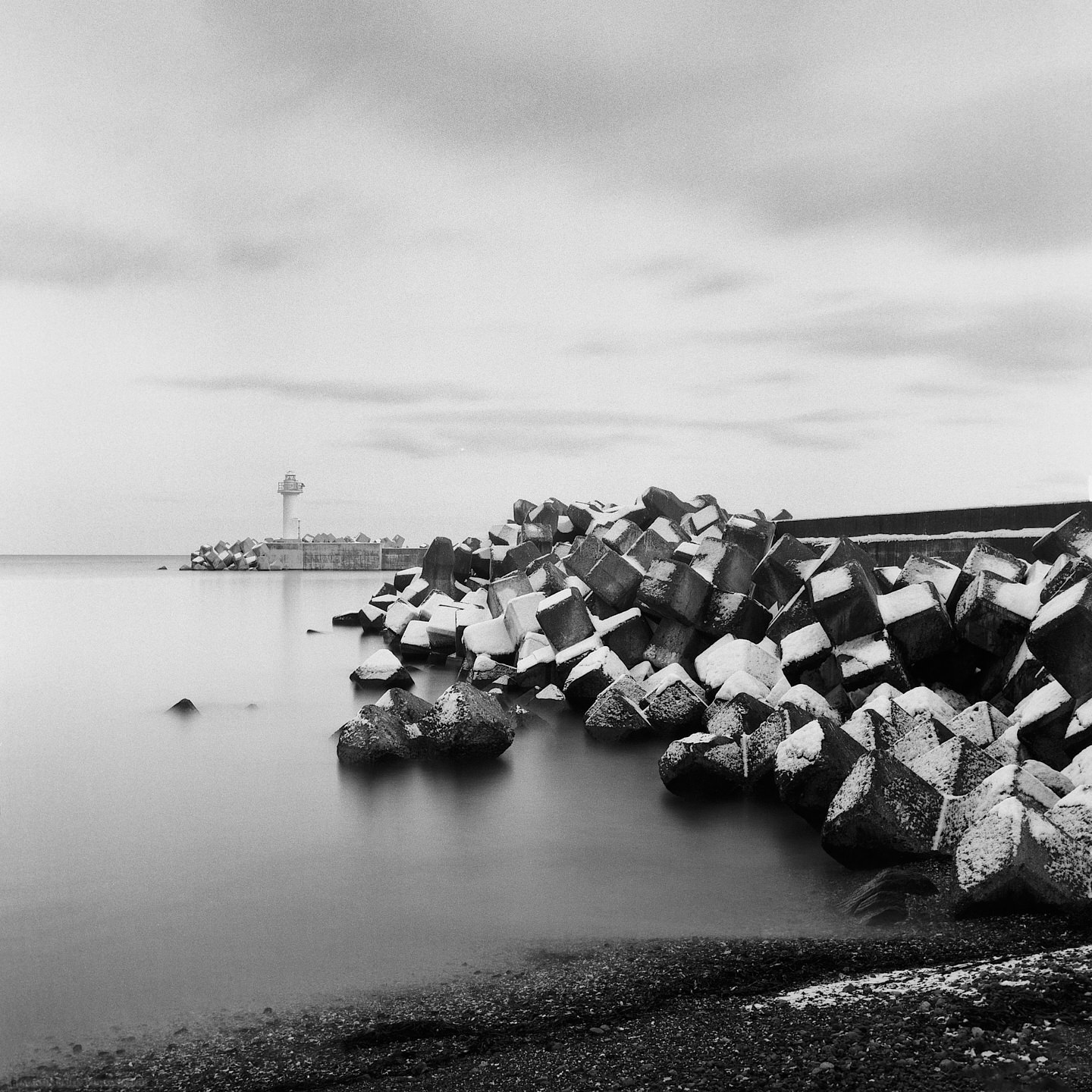
There’s a little more grain in the sky than I’d like, but I was just about getting to grips with the Rodinal developer chemicals by this point, and the SilverFast scanning software that I have also been using on recommendation is producing grainier scans than I’d like, but I guess this is more natural grain in the film, and my Canon scanning software is cleaning that up more, rather than SilverFast introducing it. Still, the six rolls of film that I developed and scanned during my week at home between the two trips was probably the biggest learning experience since I started shooting and developing my own film again a few months ago.
Shortly after the previous shot, at the end of day eight, I shot this image on the same beach, this time with my EOS R and, if I recall correctly, by this time, it was dark enough to give me a 2-second exposure without any filters on. I used a Bluetooth remote for my camera to time my shots perfectly for the drawing out of the waves, as this gives better texture and patterns in the water than the waves coming in.
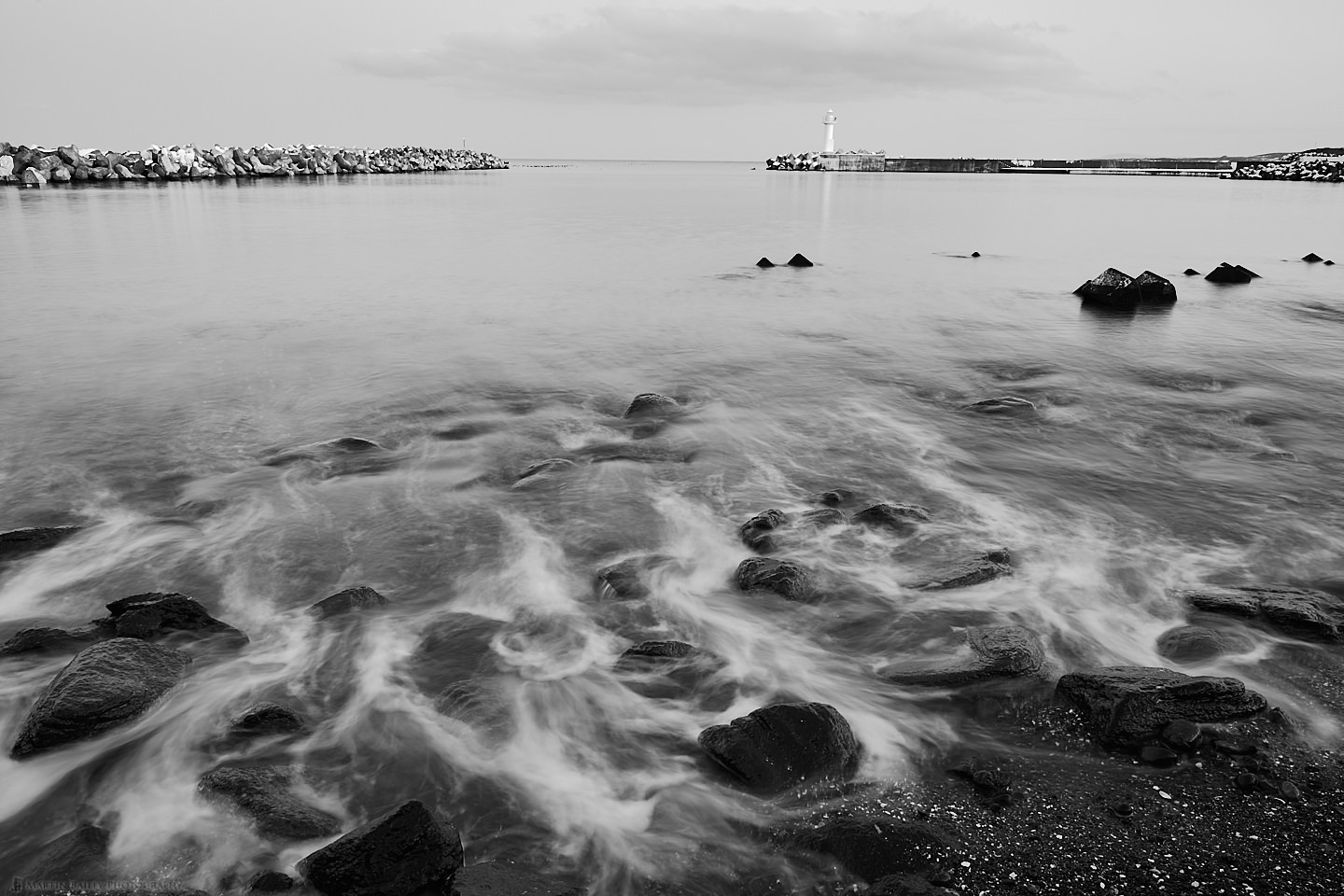
These shots don’t all work, but if you shoot a number of them, you can start to see how the waves and timing affect the shots, and then select the most pleasing one later. That’s certainly something that I want to be doing more with digital than with my film camera, although I will probably experiment more when I’m back out by myself, rather than with my wonderful group on a workshop.
The following morning, back in the port on day nine, the tide was further out, and there was a coating of frost on all of the rocks, so I got down low for this next shot, shortly after the sun had risen. With the sun’s disk in the frame, I allowed it to overexpose slightly, as did a little of the water with the sun reflecting on it, but at that exposure, the dynamic range of my camera was plenty to still capture lots of shadow detail, without any part of the scene completely plugging up and going full black.
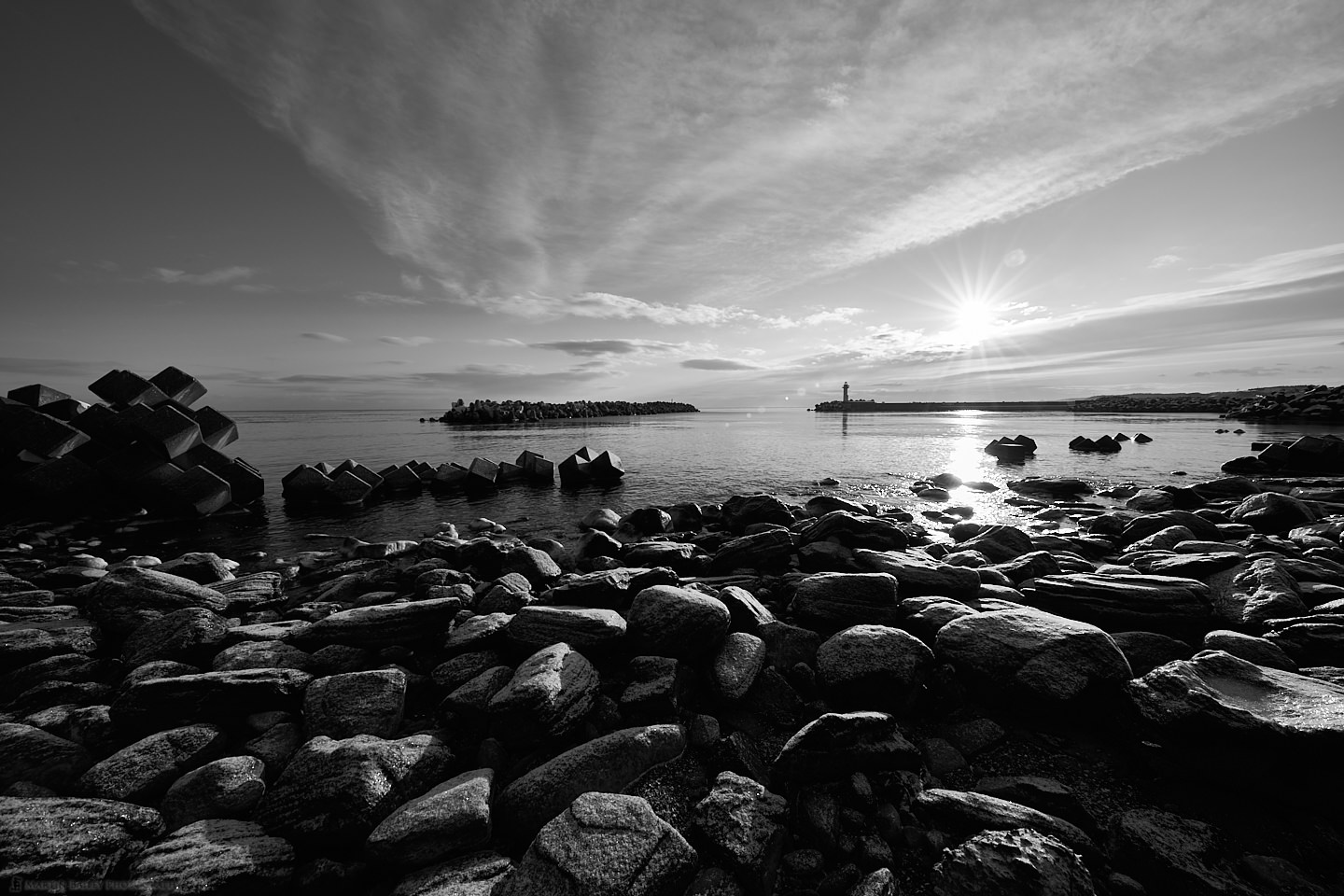
I spend a lot of time on my tours talking about exposure, and this is one of the best landscape locations to illustrate the benefits of Exposing to the Right, both for image quality, but also to protect the shadows in a wide tonal range scene like this. I covered this in detail in Episode 503, in which I covered using the Zone System for digital photography.
As we drew closer to the time that we were planning to leave the beach, we noticed some pancake ice forming on the surface of the sea, so I grabbed a number of shots with the three tetrapod pyramid tops sticking out the water, as you can see here.

It’s a cool phenomenon, as the sea starts to freeze and form the little circles of ice. It didn’t feel cold enough for this to form, but I guess that’s because we are all wrapped up to protect ourselves from the elements. Plus, I warm up a great deal when I’m photographing things, as opposed to just standing around in the cold. Later in the day, we went for a drive around the area but the warm winter was not helping with the landscape, so we went back to the hotel and did a few hours of workshops, before heading back down into the port for another quick shoot before the sun went down.
The following morning though, the snow came to our rescue, so we initially photographed the port one last time for this trip, as it was presenting us with a slightly different opportunity with the snow-covered tetrapods that you see here. Ideally, I’d have moved to my right a little more here to get better separation between the two tetrapods near the middle of the frame, but one of my guests was in that spot, and the guests always take preference. It’s fine though, and I still really like this shot.
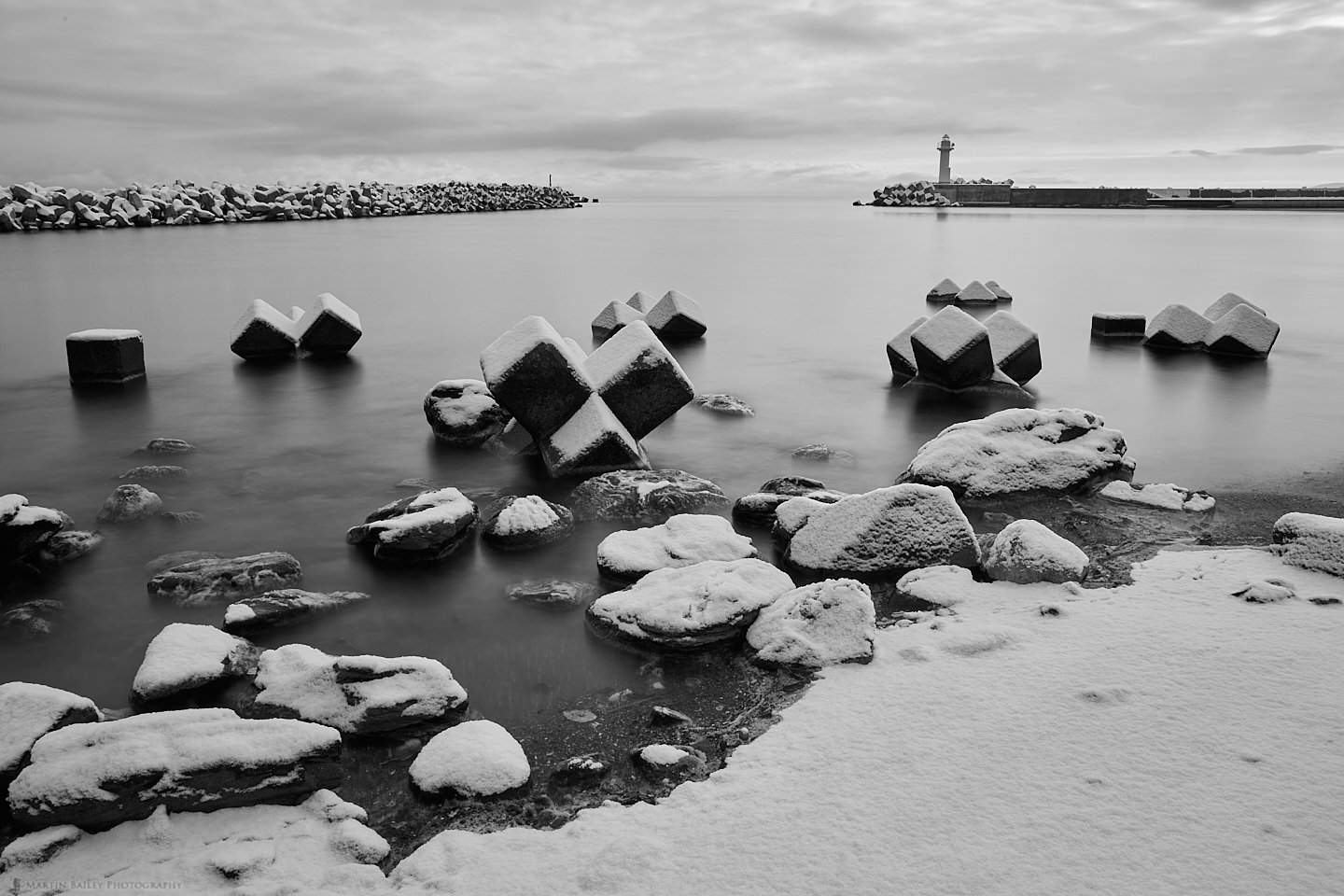
The snow running right down to the water’s edge shows how calm the sea was on this final visit, and that also allowed the snow to settle on the tetrapods and rocks rather than being washed away, which is what usually happens.
We were planning to move on to our final location for the last two days of the tour, but there was no way we’d have gotten out of town without spending more time shooting the beautiful scenes that the previous day had not delivered, and you can see what I mean in this next image. This is not hoar frost, although it looks like it. I’ve seen this happen before at this location a few years ago, so I’d had my fingers crossed.
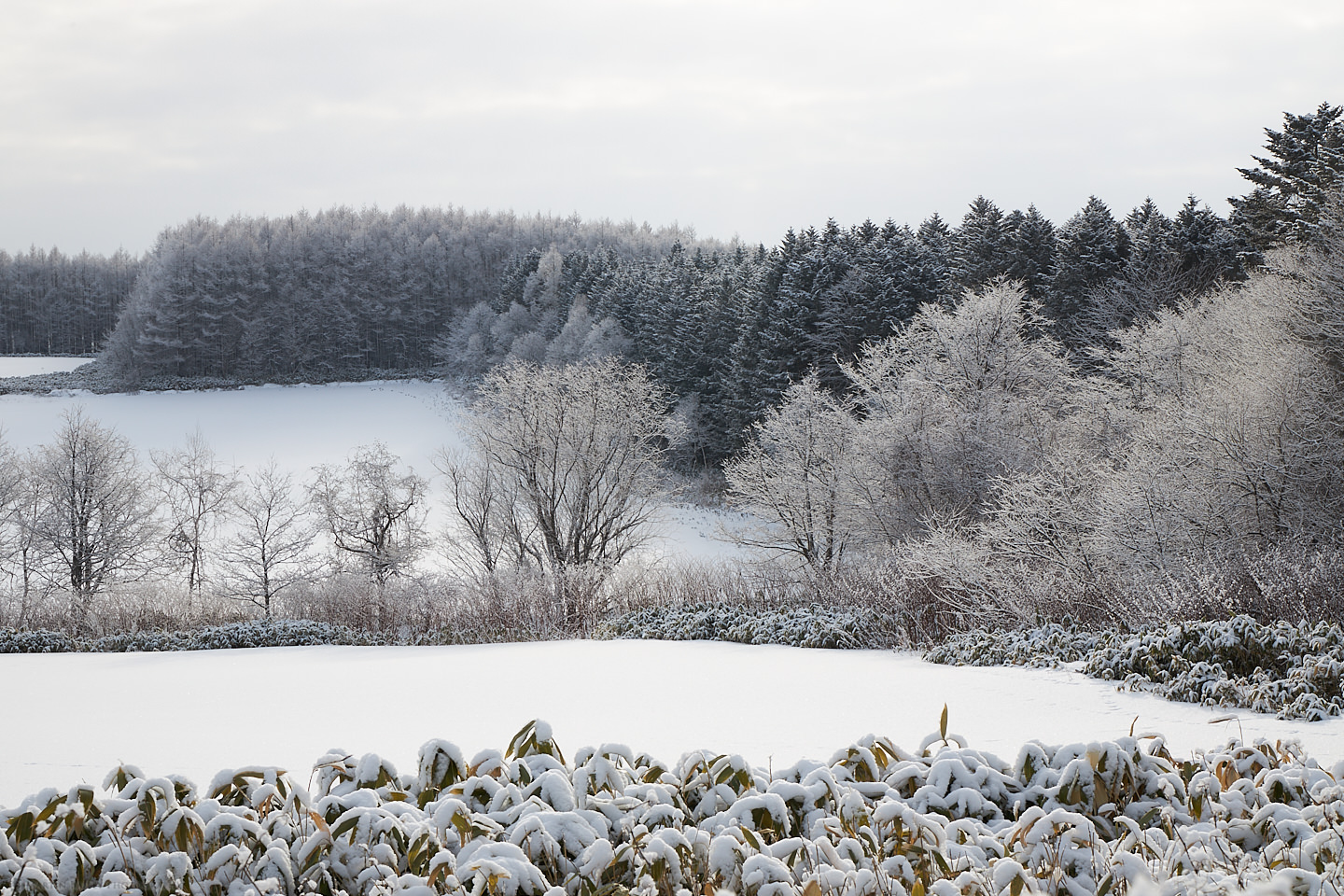
It’s very fine snow that has stuck to the trees and coated the land and other foliage. The bamboo grasses in the foreground give you an idea of what I mean too. On the previous day the soil had been showing through on the fields, and the trees were black and pretty bleak. This Winter Wonderland-style scene, on the other hand, is the sort of thing that I love to encounter on this trip, and we were fortunate to get this on this visit, with it being so warm compared to most other years.
The snow started to melt off the trees relatively quickly, so this is one of the last shots I got from this morning, of a silo in a farmer’s field, albeit a little bit of a Christmas Card type of a scene, and I mean that in a somewhat negative sense. Still, it’s a pleasing shot and helps to illustrate the conditions, so I thought I’d include this before we move on.

Note that these two images are some of the few that I left in color, as I mentioned earlier because I really felt that their color added something to the images. I used to remove the color in images when it got in the way, but for a number of years now, especially with this trip, my default is to convert to black and white, and I only leave images in color when I feel that the color is adding something to the scene.
It was back to fishing boats for much of the last two days of the trip, as we visited a fishing port on the Saroma Lake. We had a smattering of snow again, helping to clean things up, and I loved the sky that we had on our first visit, as you can see here.
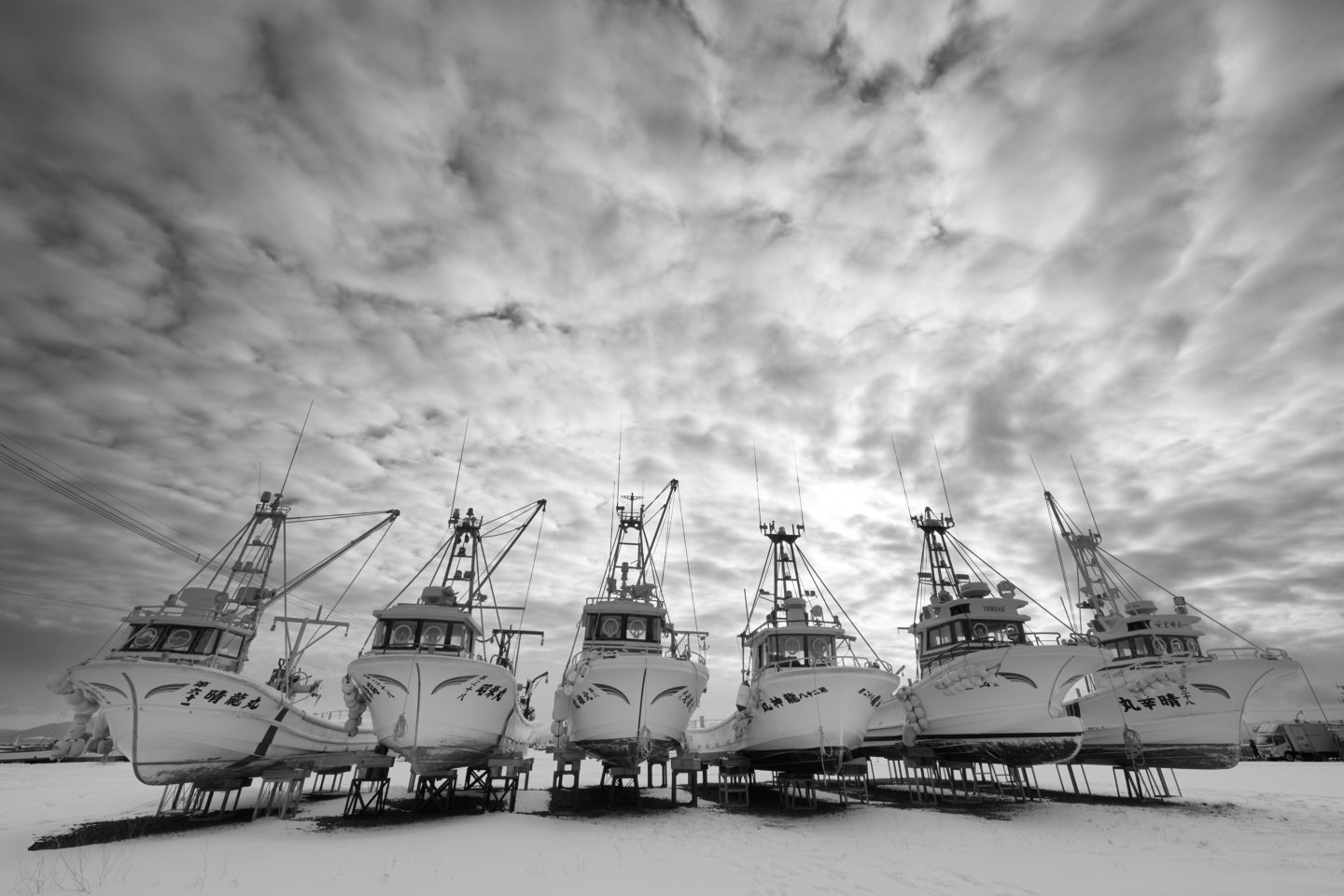
This once again shows how useful it is to Expose to the Right, to control the highlights and protect the shadows. Without using this technique, which you can read about more in Episode 381, the shadows fall too dark to give much definition. By using this technique, the boats come out of the shadows easily with the Shadows slider in Capture One Pro and Lightroom etc.
Participants’ Comments
As has become tradition, at the end of each tour, I record a comment from each of the participants, which I will play you now, in the audio for this post. If you want to hear what people said about the tour, please listen with the audio player above. The comments start at 10:23.
We are going to conclude this travelogue series with what I believe is a fitting film shot, of the boats at the same fishing port. Again, I’m really happy that the film I’m using, which for this trip turned out to be exclusively Rollei RPX 100, is giving me such similar results to how I process my digital work in black and white. Apart from the square format and more apparent grain, these images feel very similar to me, and shooting film on this trip was a lot of fun.
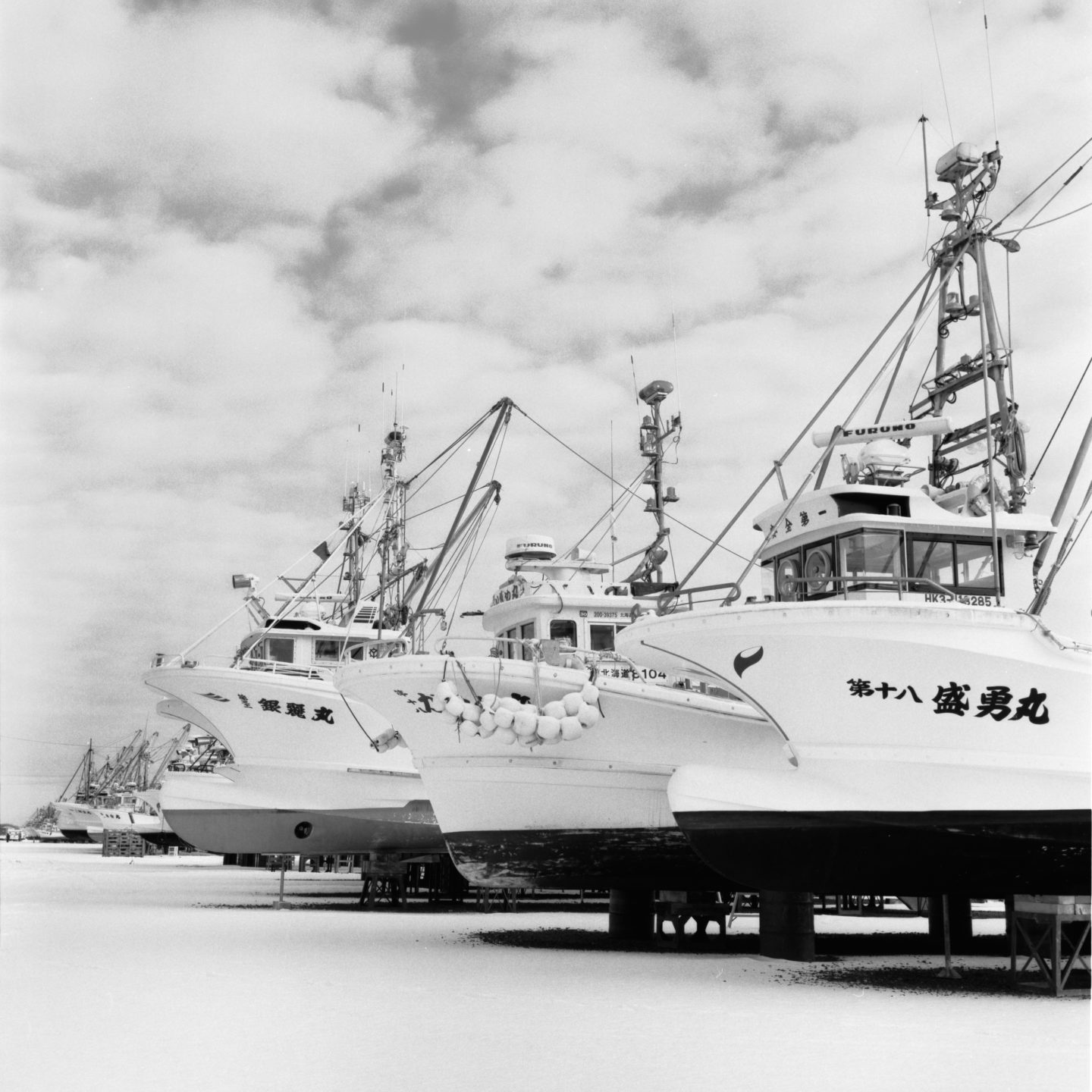
I actually thought that I’d need to mollycoddle my now 55-year-old Rolleiflex, to protect it from the elements, but having gotten it wet on a number of occasions, although I did wipe it down, I’m happy to report that it did not rust, and is still as shiny as ever. a True tribute to German craftsmanship. Note that I have used my new script for assigning and updating the EXIF data on my scanned film, so if you click on these images you’ll see the shooting information, just like my digitally shot images. I have a few more tweaks to make, but I hope to be able to share that in March when the dust settles after my winter tours.
I’ve also spent the last few days working on an update to my Photographer’s Friend app for iOS. I was contacted with a request to add a couple of medium format sensor sizes between 35mm and the 645 format, which I’ve done. In the process though, I updated the app to the latest version of Swift, the programing language used to create it, and then decided to add a Light and Dark theme throughout the app, and a few other tweaks.
If I can overcome a few remaining issues that I’m working on, I hope to submit the update to Apple before leaving for my third trip of the season next weekend, so stay tuned for that if you have version three of the Photographer’s Friend, as it will be a free update. I will not be updating version two, and you can see which you have by tapping on the About Photographer’s Friend link at the bottom of the Help menu.
One other thing to keep your eyes out for is that although the night view has been replaced by the more comprehensive dark theme, you can still switch themes easily by simply shaking your device, and that’s useful if you are using the app at night and want to protect your night vision. I also think that the dark theme looks great anyway. By default, Photographer’s Friend will now simply follow your system preferences unless you shake it.
Hokkaido Winter Landscape Photography Adventure Tour
We’ll wrap it up there for this week though. If you are interested in joining the Landscape tour in 2021 or future years, check out the tour page at https://mbp.ac/hlpa.
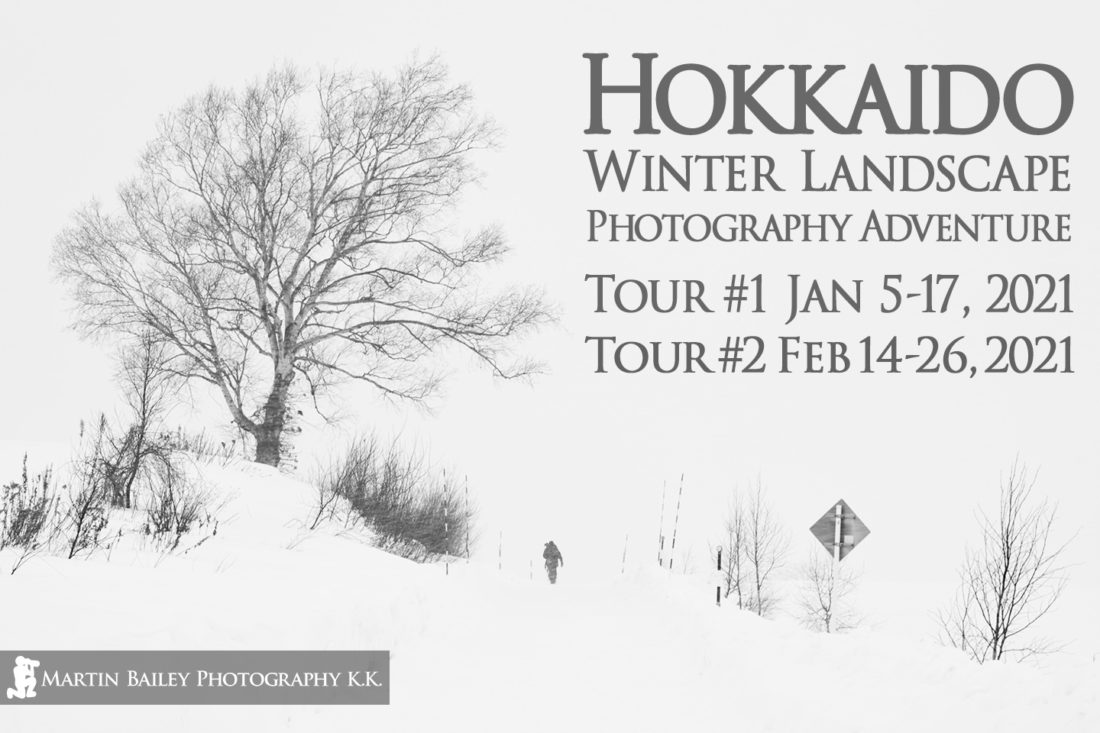
Show Notes
Check out details of future Hokkaido Winter Landscape Photography Adventures here: https://mbp.ac/hlpa
Check out our Photographer’s Friend App for iOS here: https://mbp.ac/app
Audio
Subscribe in iTunes to get Podcasts delivered automatically to your computer.
Download this Podcast as an MP3 with Chapters.
Visit this page for help on how to view the images in MP3 files.


Hi Martin. Inspiring shots as always. Can’t wait to try myself next February on your 2021 tour. Two questions, a bit unrelated: 1. Do you just use Capture One to process for B&W? If so, any tips on the process that you can share? I have a friend that processes and prints in B&W and she mentions using color channels in PS to preserve or add contrast in specific areas. I seem to struggle in getting B&W images that “pop” so curious what you do. 2. Since you have been a year with Canon EOS R and still shooting with it I assume you are pleased with it. Are you planning on buying the Canon EOS R5 when available? Although information is sparse at this time, anything that you think is especially compelling? Anything that is missing on the R that you hope they add to the R5? Do you think the R5 will provide equal performance to the Sony AR7IV? Thanks
Hi David,
Sorry for the delayed reply. I missed this until now.
Yes, I do my B&W conversions in Capture One Pro. I uninstalled Silver Efex Pro in the summer of 2016 when I jumped ship to Capture One, and haven’t used anything else since. I did release a video showing some of the techniques I use here: https://mbp.ac/606
Capture One Pro is better now though, so I’ll try to put together an updated video soon.
Regarding the R5, as I communicated via email last week (after this comment, my bad) I will definitely be getting an EOS R5, probably two. It is pretty much what I’ve been waiting for from Canon. I jumped on the EOS R because I saw from the RF mount that this was Canon’s future, and I have no regrets at all, but I would like more megapixels and faster frame rate, and the R5 delivers both of those things, and more.
I haven’t checked the performance of the Sony AR7IV, so I can’t really say, but I imagine it’s a good match. Frankly though, having fought with the menu systems on the Sony with my workshop guests, I thank the camera gods that I didn’t follow my urge to jump-ship a number of years ago. I have renewed faith in Canon and can’t wait for the R5 and 100-500mm lens etc.
Regards,
Martin.